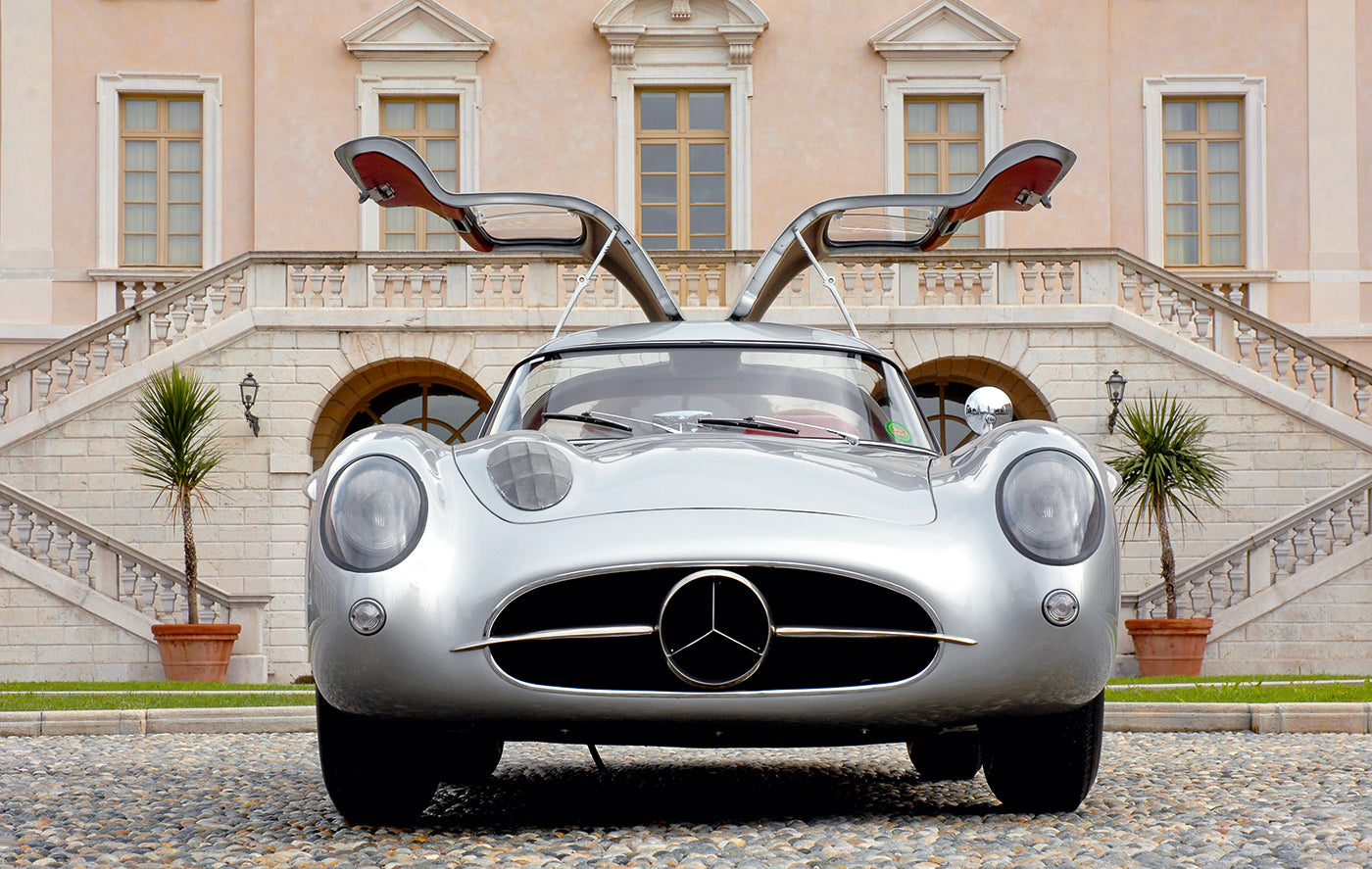
A Mercedes Legend Marked by Tragedy and Success
A tantalizing proof of concept that was cut short
Mercedes-Benz considered the head of its racing department, Rudolf Uhlenhaut, “the driving engineer.” His driving talent helped develop these dominating cars. In an anecdote from the 1955 Nürburgring Grand Prix, famed driver Juan Manuel Fangio had offhandedly mentioned that his car had not been properly set up. Uhlenhaut, fresh from an executive’s lunch and in suit and tie, jumped into the race car and turned in a lap—three seconds faster than the Argentine world champion. “He should practice a little more,” Uhlenhaut was rumored to have recommended to Fangio.
Born in London to English and German parents, Uhlenhaut joined Daimler-Benz in 1931, straight from Munich University. In 1936, he was appointed the head of the racing department. This period was marked by Auto Union’s Bernd Rosemeyer rivalry with Mercedes’ Rudolf Caracciola. Uhlenhaut faced Auto Union’s racing engineer Ferdinand Porsche on countless tracks. Caracciola had won the European Driver’s Championship in 1935, while Rosemeyer, a motorcycle racer, had never driven a racing car before Auto Union’s Silver Arrow. In 1936, Rosemeyer swept the championships in Germany, Switzerland, and Italy. He took home the Vanderbilt Cup in America, plus humiliated Mercedes-Benz and its crumbling W25 race car.
Mercedes-Benz took the second half of the 1936 season off, watching Rosemeyer dominate the rest. During this time, Uhlenhaut corrected some of the fundamental flaws he found in the W25: namely, he had felt that the suspension and steering geometry were all off, and the chassis wasn’t stiff enough. Uhlenhaut tested the new prototypes at the Nürburgring himself. The ensuing W125 car became one of the most powerful cars ever used in competition. Its supercharger feeding a straight-eight engine to a maximum of 637 horsepower, a record that would go unbeaten for the next three decades. At the AVUS track outside Berlin, not so much a racetrack as much as it was just a long stretch of autobahn, the W125 hit 190 miles per hour. Caracciola and Manfred von Brauchitsch handily brought home the 1937 championship. With the W125’s replacement, the W154, Caracciola won the next year as well.

The 300SLR Coupe could reach 180 miles per hour, then making it the fastest car in the world. Some have suggested that SL stands for “Sport Leicht” rather than “Super Leicht,” and vice versa. Either way, both appellations fit. (Photo: David Kimber, Beautiful Machines)
During the war, Uhlenhaut worked at Daimler building aircraft engines. When the war ended, Mercedes-Benz didn’t return to racing until 1951, and when they did that year, Uhlenhaut was again their head engineer and savior. It was the first World Sportscar Championship after the war—Mercedes-Benz had the honor to defend, still theirs by right. Uhlenhaut led the design of a tubular spaceframe chassis that weighed just 110 pounds, then shaped a delicate aluminum body with help from the University of Stuttgart’s water tank and a wooden model. The 3.0-liter six-cylinder engine came from Mercedes’ grandest touring sedan, humble and underpowered for a race car. But the entire car weighed less than 2,500 pounds and could still reach 180 miles per hour in testing. Mercedes-Benz called it the 300SL—Super Light.
The car not only won at the Carrera Panamericana, but the 24 Hours of Nürburgring and the Eifelrennen while placing respectfully at the Mille Miglia in its first outing. It also gave way to the road-going race car that is the 300SL “Gullwing.” However, the 300SL was only a tantalizing proof of concept. What came next would generate a legend for Mercedes-Benz that went far beyond the company. For the next evolution, Uhlenhaut spearheaded an open-wheeled Grand Prix car, then derived an endurance car for events like the 24 Hours of Le Mans. The new car employed superlight Elektron magnesium-alloy bodywork around its spaceframe chassis, and direct injection—a trick Uhlenhaut picked up while designing aircraft engines during the war. The 2.5-liter straight-eight engine now had 257 horsepower.
Fangio, El Chueco, went on to win two Drivers Championships with it. In the first Grand Prix outing for Mercedes-Benz since the war, the 1954 French Grand Prix, Fangio, and teammate Karl Kling earned a 1-2 finish, a comeback that struck fear into the hearts of the Italians. Fangio, driving for both Maserati and Mercedes-Benz that season.
In the 1955 Formula One season, the W196 won every race it entered. At the British Grand Prix, Fangio’s teammate, Stirling Moss edged ahead of him by less than a second to win his first Grand Prix. The mighty Benzes dominated the first four places. Uhlenhaut then took this winning formula and brought it to the sports car circuit. This time, the engine was enlarged to three liters, and the bodywork wrapped around the wheels. The goal was to win the 1955 Mille Miglia, and Mercedes-Benz brought an army to northern Italy, entering four cars, preparing for two months before the events with its drivers racking up as much as 30,000 miles navigating the course. Moss and navigator Denis Jenkinson took off at 7:22 in the morning. They had spent months compiling pace notes. This was the fifth time Moss had attempted a victory. After a slow start against Ferrari, the 300 SLR began to reel in the mileage at 170mph. With Jenkinson’s notes, Moss was confident. By the time they rolled back into Brescia, neither had any idea how far ahead they were—but they had completed all 992 miles in a little over 10 hours, at an average speed of 99 miles per hour. The second-place finisher, Fangio in another 300 SLR, wouldn’t come in for another 32 minutes.

The 300SLR’s six-cylinder engine featured direct injection, something Uhlenhaut picked up from his time building airplane engines. (Photo: David Kimber, Beautiful Machines)
The 300 SLR went on to score the top three places at Ireland’s Tourist Trophy and the top two at the Targa Florio. With those results, Mercedes-Benz won the World Sportscar Championship—a banner year for the company’s full-force re-entry into motorsport. And then, the rest of 1955 unfolded in a horrific spectacle. That June, at the 24th running of the 24 Hours of Le Mans, Pierre Levegh’s 300 SLR hit an Austin-Healey, then struck a barrier at 125mph, sending it flying into a crowd of spectators before bursting into flames. It burned in the grandstands after scything through the crowd, and when race officials attempted to pour water on it, the magnesium only burned more, like a hellfire, resulting in the death of 83 spectators.
Mercedes-Benz pulled out of racing that afternoon—a plan its executives had considered for some time. The company wouldn’t return to motorsports until 1985. And that cut short Uhlenhaut’s plan. Before Le Mans, he had set aside two of the nine W196 race cars to build coupe versions, which were completed well before Mercedes had announced the end of all racing activities. It would bridge the gap between the winning SLR and the 300SL Gullwing, fusing two legends. It was to enter the Carrera Panamericana that August of 1955 if the government of Mexico hadn’t shut down the race amidst an overall sense of foreboding across the world. And it was, by all period accounts, a spectacular car to drive.
Uhlenhaut knew. After the self-imposed ban, he took one of the coupes and drove it as his company car—in the era’s fastest car in the world. Weighed down by laurels, they are seen as priceless to many. Uhlenhaut retired in 1972, having known he brought Mercedes-Benz to glory, both before and after the war, two periods separated by time and distance and technology. A warm soul by all accounts, he treated his staff like equals but knew where his brilliance lay. He never owned a car for himself; with the keys to the kingdom, he didn’t need to.
This story was originally featured in Beautiful Machines and written by Blake Z. Rong. Delve into the era of elegant sports car.


